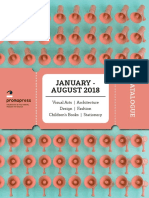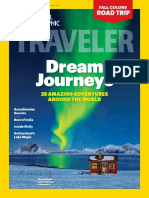Bodies of Water PDF
Bodies of Water PDF
Uploaded by
Jen BercasioCopyright:
Available Formats
Bodies of Water PDF
Bodies of Water PDF
Uploaded by
Jen BercasioOriginal Title
Copyright
Available Formats
Share this document
Did you find this document useful?
Is this content inappropriate?
Copyright:
Available Formats
Bodies of Water PDF
Bodies of Water PDF
Uploaded by
Jen BercasioCopyright:
Available Formats
Bodies Of Water
Fifth Grade Science,
by Sanayya Sohail October 1, 2015
Use this lesson to teach your students about the major bodies of water by letting them create miniature
versions of their own!
Learning Objectives
Students will be able to identify the major bodies of water and describe examples of the major bodies of water.
Materials and preparation
Bodies of Water power point
White papers
Glue stick
Scissors
Markers
Construction papers
World/US maps
Pencils
Erasers
Poster board
Computers
Bodies of Water worksheet
Attachments
Bodies Of Water slideshow (PPTX)
Bodies of Water worksheet (DOCX)
Introduction (10 minutes)
Write the following words on the board: "ocean," "gulf," "bay," "inlet," "river," and "lakes."
Ask your students if they know what those words mean.
Explicit Instruction/Teacher modeling (30 minutes)
Go over the Bodies Of Water slideshow presentation with your students.
Explain each slide with examples.
Guided Practice (50 minutes)
Ask your students to create a Bodies Of Water book using white paper.
Tell your students to use the slides to get information.
Tell your students that the book should be seven pages. There should be a page for each type of body of
water and a title page.
Each page about a body of water should contain a description of the body of water as well as a 3D picture
of the body of water that sticks out.
The pictures should be created using construction paper.
Get more lesson plans at https://www.education.com/lesson-plans/
Independent working time (20 minutes)
Ask your students to create a flow chart for each body of water.
Tell your students that the top rectangle should name the body of water.
Tell your students that there should be four rectangles connected to each top rectangle. The bottom
rectangles should contain examples for each body of water.
Tell your students to use the slides, maps, or their textbook to find names of various rivers, oceans, bays,
gulfs, inlets, and lakes.
Differentiation
Enrichment: Ask your students to create a poster about any body of water. Their poster should have the
title, examples, and pictures of at least four examples along with three facts about each example.
Support: Get a world map. Point to the various rivers, lakes, oceans, inlets, gulfs, and bays. Show your
students the area covered by each.
Assessment (20 minutes)
Have your students complete the Bodies of Water worksheet.
Review and closing (10 minutes)
Go around the class and ask your students to state a fact about any body of water.
Get more lesson plans at https://www.education.com/lesson-plans/
You might also like
- 3D Virtual Treatment Planning of Orthognathic Surgery A Step-By-Step Approach For Orthodontists and SurgeonsDocument580 pages3D Virtual Treatment Planning of Orthognathic Surgery A Step-By-Step Approach For Orthodontists and SurgeonsAbad Salcedo100% (6)
- Kodak Case StudyDocument41 pagesKodak Case StudyMichèle Anjarasitrake Henry100% (2)
- Lesson Plan - Water Bodies - SaherDocument3 pagesLesson Plan - Water Bodies - Sahersaher Queen100% (1)
- Semi Detailed Lesson PlanDocument3 pagesSemi Detailed Lesson PlanDiana Floro SorbitoNo ratings yet
- Push or PullDocument4 pagesPush or Pullapi-28351870550% (2)
- Importance of Water CycleDocument8 pagesImportance of Water CycleAngelika MarrizeNo ratings yet
- Lesson Plan Science Plant Life CycleDocument5 pagesLesson Plan Science Plant Life CycleHessa MohammedNo ratings yet
- Digital Dice - ElectronicsDocument4 pagesDigital Dice - ElectronicsAnonymous QnKVe82eNo ratings yet
- Lesson Plan in Science 3 LovelyDocument3 pagesLesson Plan in Science 3 Lovelylloriane100% (1)
- Water Cycle Lesson PlanDocument2 pagesWater Cycle Lesson Planhendersonmusic0% (1)
- Lesson Plan in Science 3 PlantsDocument4 pagesLesson Plan in Science 3 PlantsCaren Pogoy ManiquezNo ratings yet
- A Detailed Lesson Plan in Science 4Document11 pagesA Detailed Lesson Plan in Science 4RicaJaneNatividad100% (1)
- SemiDocument6 pagesSemijaylou taborite0% (1)
- Lesson Plan 1Document4 pagesLesson Plan 1api-353433951No ratings yet
- Detailed Lesson Plan in Science 4Document2 pagesDetailed Lesson Plan in Science 4Cherii Lapinid100% (1)
- COT 4th Quarter Sources of WaterDocument4 pagesCOT 4th Quarter Sources of WaterNerissa Baricaua100% (1)
- DLP Living and Non-Living ThingsDocument4 pagesDLP Living and Non-Living ThingsZander CainNo ratings yet
- Science Module Quarter 4 L1Document4 pagesScience Module Quarter 4 L1Alex Tutor100% (1)
- Lesson Plan LiquidDocument1 pageLesson Plan LiquidJeff Millena100% (1)
- Lp-In ScienceDocument7 pagesLp-In ScienceWilson malabananNo ratings yet
- Daily Lesson Log/Pla N Scho Ol Grade Level Teac Her Learning AreaDocument4 pagesDaily Lesson Log/Pla N Scho Ol Grade Level Teac Her Learning AreaJoyeeNo ratings yet
- Compare and Contrast The Characteristics of The Different Types of SoilDocument4 pagesCompare and Contrast The Characteristics of The Different Types of SoilSheena Mae MendozaNo ratings yet
- Water FormsDocument2 pagesWater FormsJupiter BacuadoNo ratings yet
- Lesson Plan in Science IVDocument3 pagesLesson Plan in Science IVLiezel M. Canovas100% (1)
- Cause and Effect Lesson Plan AMIEDocument6 pagesCause and Effect Lesson Plan AMIECatherine Joy TumalaNo ratings yet
- Science 3 DLP 50 - Sun As The Primary Source of Heat and LightDocument6 pagesScience 3 DLP 50 - Sun As The Primary Source of Heat and LightJhemar R. Munda CruzNo ratings yet
- Detailed Lesson Plan in Science IVDocument8 pagesDetailed Lesson Plan in Science IVFevy Abanag100% (2)
- DETAILED LESSON PLAN in ScienceDocument4 pagesDETAILED LESSON PLAN in ScienceHannah Shield Carullo100% (2)
- Detailed Lesson Plan in Grade Iii ScienceDocument6 pagesDetailed Lesson Plan in Grade Iii ScienceEvita Esguerra100% (3)
- Lesson Plan in Science Iii: Describe The External Parts of The Eye. Participate Actively in The Group ActivityDocument90 pagesLesson Plan in Science Iii: Describe The External Parts of The Eye. Participate Actively in The Group ActivityLiza ValerosoNo ratings yet
- Science For Final DemoDocument10 pagesScience For Final DemoRICHARD ESTRADANo ratings yet
- Semi - Detailed Lesson Plan in Science 4, Quarter 2, Week 10 I. ObjectivesDocument3 pagesSemi - Detailed Lesson Plan in Science 4, Quarter 2, Week 10 I. ObjectivesEvaLord Hamot Evangelisan100% (1)
- Detailed Lesson Plan in ScienceDocument5 pagesDetailed Lesson Plan in ScienceYlanan NBNo ratings yet
- LP Sci 6-Wheel & AxleDocument2 pagesLP Sci 6-Wheel & AxleLV BENDANA100% (1)
- Lesson Plan in ScienceDocument3 pagesLesson Plan in ScienceGeovilyn ManglallanNo ratings yet
- Summative Assessment PlanDocument3 pagesSummative Assessment PlanJhun MarkNo ratings yet
- LP in Science 2 LAS 2Document2 pagesLP in Science 2 LAS 2Horts JessaNo ratings yet
- GRADE 3 (Weather)Document6 pagesGRADE 3 (Weather)JANLADINO FERROLINONo ratings yet
- Daily Lesson Plan On Parts of The Plants: KINDERGARTEN Quarter/ 4th Quarter / Week 2/ Day 3 General South CotabatoDocument5 pagesDaily Lesson Plan On Parts of The Plants: KINDERGARTEN Quarter/ 4th Quarter / Week 2/ Day 3 General South CotabatoAprilyn Lamanosa SubaldoNo ratings yet
- DLP SCIENCE 4 Q4 Practice Safety Precautions On The Effects of The SunDocument6 pagesDLP SCIENCE 4 Q4 Practice Safety Precautions On The Effects of The SunMark-Christopher Roi Pelobello MontemayorNo ratings yet
- Frog Life Cycle Lesson PlanDocument6 pagesFrog Life Cycle Lesson Planapi-300082815No ratings yet
- A DETAILED LESSON PLAN IN SCIENCE 2 For CSAV-ISDocument6 pagesA DETAILED LESSON PLAN IN SCIENCE 2 For CSAV-ISErica Jane PrinoNo ratings yet
- Semi Detailed Lesson PlanDocument3 pagesSemi Detailed Lesson PlanIan Rey Mahipos Saavedra100% (1)
- RodaAmper Elem LP Science4Document4 pagesRodaAmper Elem LP Science4Roda AmperNo ratings yet
- Science 5 3 Lesson Plan ReflectionDocument11 pagesScience 5 3 Lesson Plan Reflectionapi-266136729No ratings yet
- Detailed Lesson Plan in English IV I. ObjectivesDocument15 pagesDetailed Lesson Plan in English IV I. ObjectivesJude Santiago BananiaNo ratings yet
- Detailed Lesson Plan in Science ViDocument6 pagesDetailed Lesson Plan in Science ViJustin Ace MallorcaNo ratings yet
- Detailed Lesson Plan in Science 4Document5 pagesDetailed Lesson Plan in Science 4Riciel Santiago100% (1)
- Science Week 2Document5 pagesScience Week 2aliahna espinosaNo ratings yet
- Sinking and Floating LPDocument11 pagesSinking and Floating LPRiza Sibal Manuel Lerma100% (1)
- Semidetailed Lesson Plan in ScienceDocument4 pagesSemidetailed Lesson Plan in ScienceAliza Mae MalicdemNo ratings yet
- QUARTER 1 WEEK 4 ENGLISH 4 - Context Clues Antonym - SequenceDocument60 pagesQUARTER 1 WEEK 4 ENGLISH 4 - Context Clues Antonym - SequenceNoona SWNo ratings yet
- A Detailed Lesson Plan in Science IiiDocument9 pagesA Detailed Lesson Plan in Science IiiDiana Louise ToribioNo ratings yet
- Lesson Plan in Science Grade 1Document8 pagesLesson Plan in Science Grade 1audeza maurineNo ratings yet
- Light, Sound&forceDocument3 pagesLight, Sound&forceJay Rameshbhai Parikh100% (1)
- The Hawk and The CrowDocument1 pageThe Hawk and The CrowSamuel LeeNo ratings yet
- A Detailed Lesson PlanDocument8 pagesA Detailed Lesson PlanCris LoretoNo ratings yet
- Teacher: Guro Ako Science Teaching Dates/Time: Quarter:: Value Integration: Caring For The EnvironmentDocument6 pagesTeacher: Guro Ako Science Teaching Dates/Time: Quarter:: Value Integration: Caring For The EnvironmentDiana Marie Vidallon Aman100% (1)
- Layers of SoilDocument7 pagesLayers of SoilValentine LMdrd100% (2)
- I. Objectives:: Batangas State University College of Teacher EducationDocument8 pagesI. Objectives:: Batangas State University College of Teacher EducationBhen GieNo ratings yet
- Purok 4, San Jose, Montevista, Davao de OroDocument14 pagesPurok 4, San Jose, Montevista, Davao de OroJhon Mapelle LabitiganNo ratings yet
- Anyong TubigDocument5 pagesAnyong TubigBawiin, Chris July M.No ratings yet
- Seton Hill University Lesson Plan Template: Name Subject Grade Level Date/DurationDocument5 pagesSeton Hill University Lesson Plan Template: Name Subject Grade Level Date/Durationapi-272099901No ratings yet
- Chapters 1 To 5Document23 pagesChapters 1 To 5Jose Jacob Ortiz MoralesNo ratings yet
- Pastel Journal - Spring 2023Document92 pagesPastel Journal - Spring 2023Luxhesa Lilo100% (5)
- MIssouri Wing Compass NewsletterDocument8 pagesMIssouri Wing Compass NewsletterBob LawrenceNo ratings yet
- Catalog Fix Total StationDocument16 pagesCatalog Fix Total Stationla ode muhamad nurrakhmadNo ratings yet
- Association of Mutual Funds in India: Application Form For Renewal of Arn/ EuinDocument5 pagesAssociation of Mutual Funds in India: Application Form For Renewal of Arn/ EuinPiyushJainNo ratings yet
- Magnification WorksheetDocument10 pagesMagnification Worksheetapi-321789351100% (1)
- Daftar Penjualan Per Supplier: Top MarketDocument98 pagesDaftar Penjualan Per Supplier: Top Marketalfian eryandikaNo ratings yet
- Ankur Mittal: Address: Shivlal Rajkumar and Sons, Safidon, Haryana Mob: +91-7988047754Document3 pagesAnkur Mittal: Address: Shivlal Rajkumar and Sons, Safidon, Haryana Mob: +91-7988047754Ankur MittalNo ratings yet
- The Art of Seeing 8th Edition Zelanski Fisher Test BankDocument6 pagesThe Art of Seeing 8th Edition Zelanski Fisher Test BankWilliam Cortez100% (30)
- The Myth of HorusDocument11 pagesThe Myth of HorusSalwa SanadNo ratings yet
- Cas-Ics 001l-Ylarn-2Document16 pagesCas-Ics 001l-Ylarn-2para sa projectNo ratings yet
- English Unit 6 NotebookDocument4 pagesEnglish Unit 6 NotebookFransiska SulanNo ratings yet
- Morphometrics - Brief Notes Oyvind HammerDocument50 pagesMorphometrics - Brief Notes Oyvind HammerCamila DiazNo ratings yet
- Photo Upload GuideDocument3 pagesPhoto Upload Guidevaishnav kasarNo ratings yet
- August 18Document27 pagesAugust 18Kadree MontecalvoNo ratings yet
- Letter of ComplaintDocument3 pagesLetter of ComplaintMartin NguyenNo ratings yet
- National Geographic Traveler USA October-November 2017Document103 pagesNational Geographic Traveler USA October-November 2017glezglez1100% (4)
- Graphic Novel IntroDocument12 pagesGraphic Novel Introapi-277501178No ratings yet
- Test Book ESO 1 / © Pearson Educación, S.A., 2006Document64 pagesTest Book ESO 1 / © Pearson Educación, S.A., 2006Natalia AristeoNo ratings yet
- Pa2 MCQ QP G10 EngDocument7 pagesPa2 MCQ QP G10 EngsidharthNo ratings yet
- C506 E075SONIALVISION G4 Brochure PDFDocument9 pagesC506 E075SONIALVISION G4 Brochure PDFmikaela05No ratings yet
- PAPER 3 Implementation of Unmanned Aerial Vehicles (UAVs) For AssessmentDocument166 pagesPAPER 3 Implementation of Unmanned Aerial Vehicles (UAVs) For AssessmentEduPeñaNo ratings yet
- Sensory ImageryDocument4 pagesSensory Imageryvanne candoNo ratings yet
- Japanese WifeDocument9 pagesJapanese WifeIAMAUGUSTINENo ratings yet
- 2010-2011 MNA Better Newspaper Contest WinnersDocument72 pages2010-2011 MNA Better Newspaper Contest WinnersMN Newspaper Assoc.No ratings yet
- Planning A Shoot For Luke Stephensons FinishedDocument1 pagePlanning A Shoot For Luke Stephensons Finishedapi-565505652No ratings yet
- Take More Than Pictures. Take Stories.: You CanDocument44 pagesTake More Than Pictures. Take Stories.: You CanShadowfexNo ratings yet

























































































